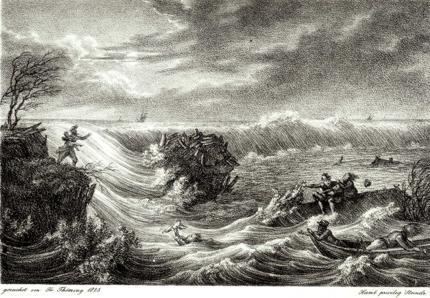 | ||
The February flood of 1825, also known in Germany as the Great Hallig Flood (Große Halligflut), was a devastating flood that occurred from 3 to 5 February 1825 on the North Sea coast, in which about 800 people were drowned.
Particularly affected was the German North Sea coast, with its islets, known as Halligen, where many dykes had already been damaged in November of the year before by a severe storm surge. The village of Pellworm was completely flooded.
In East Frisia, the town of Emden was particularly hard hit. But because the levees in the East Frisian area had been raised significantly in many places in the preceding years, the number of casualties - about 200 - was less than it might have been.
In the Netherlands, the February flood was the worst natural disaster of the 19th century. Most of the dead and the worst damage was in Groningen, Friesland and Overijssel. The reaction at national level was quite similar to that during the flood of 1953; yet the event was surprisingly quickly forgotten once the damage had been repaired and had no political or engineering consequences. It needed the disaster of 1953 in order for a delta law to be passed and to improve coastal protection significantly.
